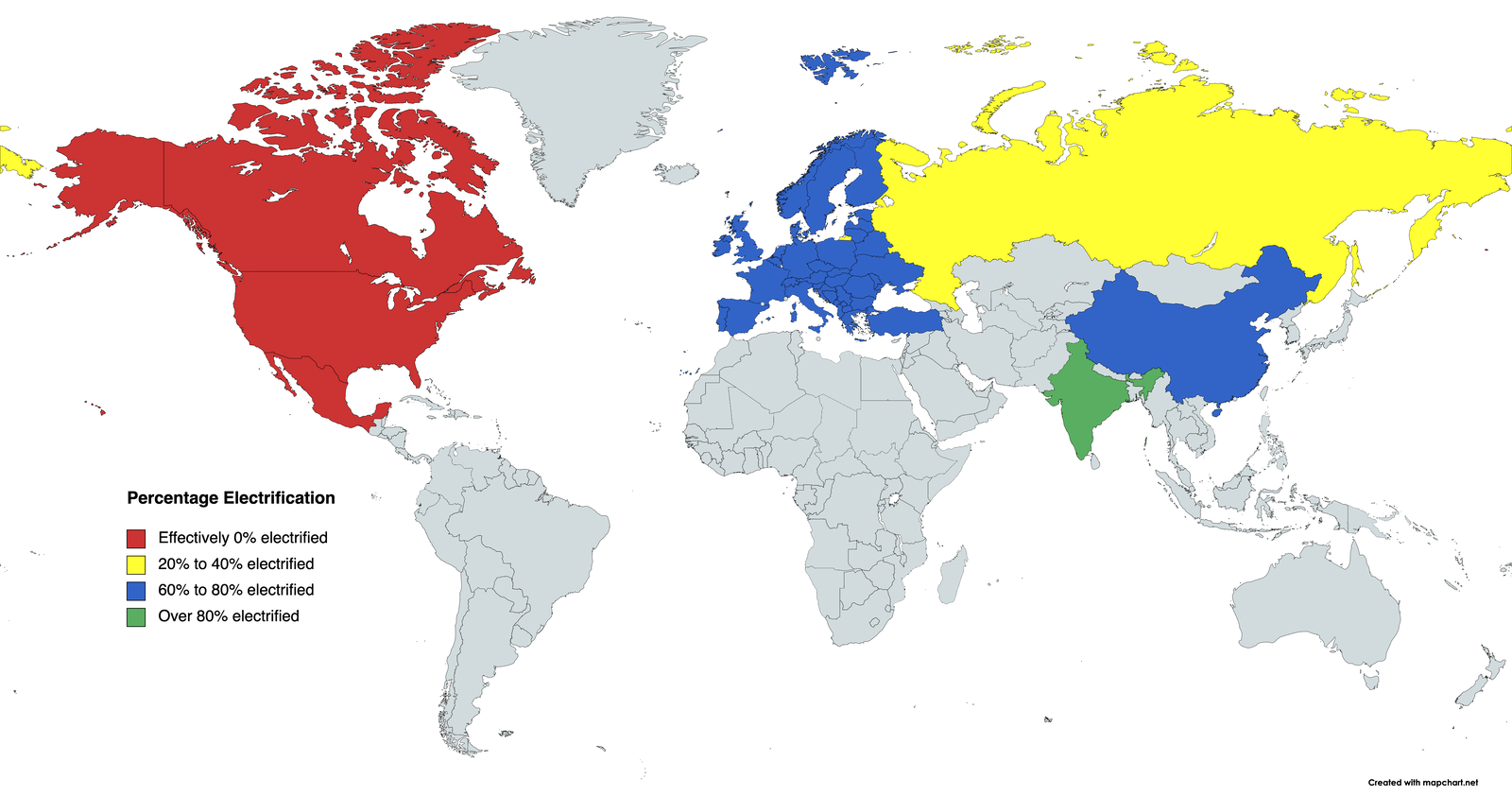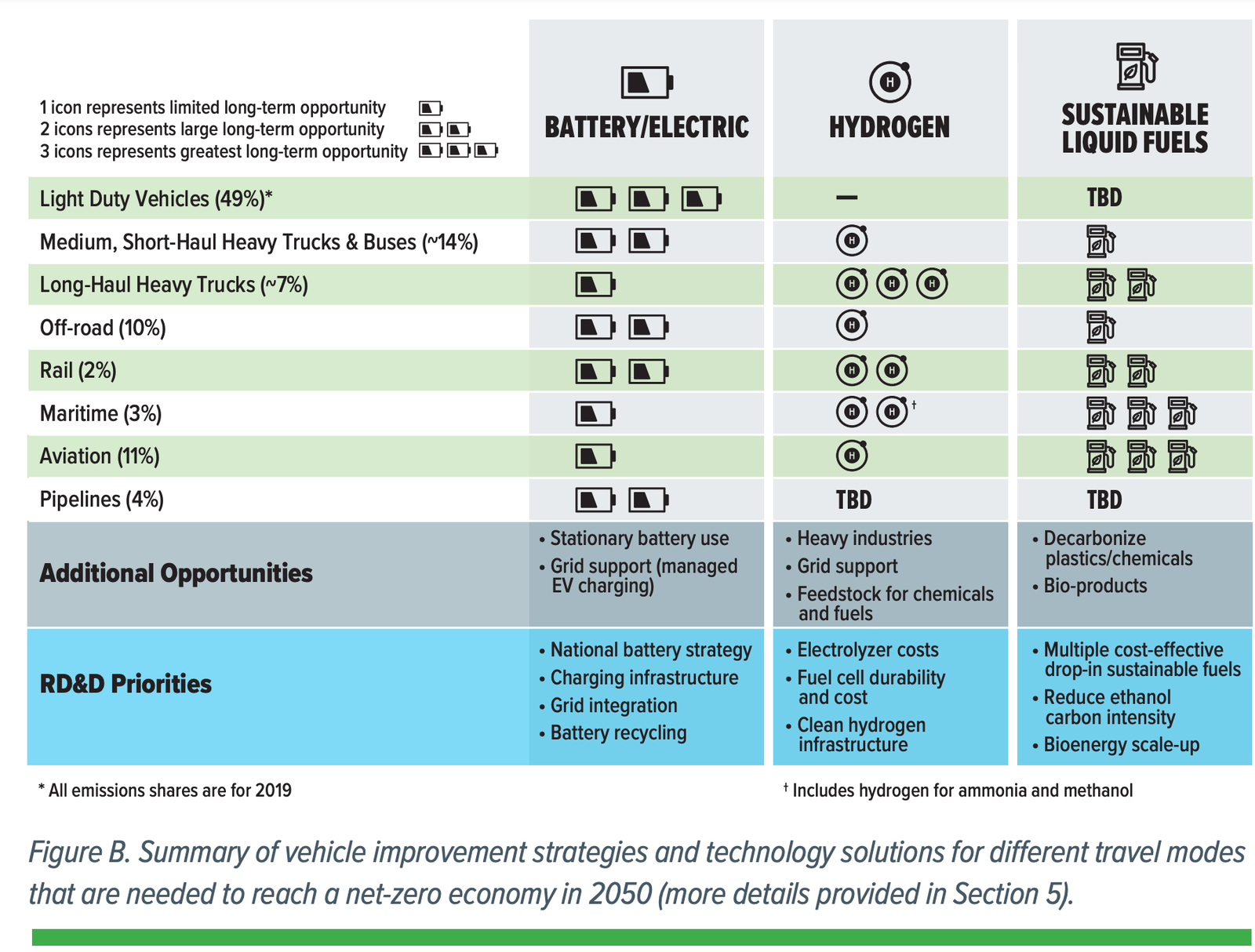Rail is electrifying globally, with one major exception


· 9 min read
Outside of pipelines, a transportation segment which will be going away with peak fossil fuel demand and be replaced by HVDC transmission, railroads offer the lowest carbon form of moving freight, and of course move people too. But being relatively low carbon does not mean that rail doesn’t need to decarbonize further. Locomotives are burning diesel and diesel is still a fossil fuel with carbon emissions that cause global warming.
Mode shifting freight to rail from road makes a great deal of sense where that’s viable. That’s one of the intentions of the new US transportation blueprint, although the diagnosis of freight transportation mode challenges in the blueprint is weak, so the reality will be more road freight in North America. As Richard Rumelt’s Good Strategy / Bad Strategy points out, if you misdiagnose the situation, it doesn’t matter how good your policies or action plans are.
Having had Canadian National Railway (CNR) and Canada’s VIA Rail as clients in the past, a stint which included clambering over a diesel electric locomotive in one of CNR’s yards while taking a rail operations course with them to understand the business, I have some insight into the transportation mode and its challenges. A key point is that locomotives are diesel-electric hybrids. The diesel engine is a generator of electricity for electric traction motors. And just like electric cars, when the motors are used for braking, they generate electricity. Unlike cars, most diesel-electric locomotives don’t store the electricity in batteries, but divert it to rooftop resistance coils to get rid of it.
Diesel electric locomotives are bad neighbors in urban areas. Due to the nature of the diesel generator, it’s usually left running when it will be used again within several hours, and if it’s on a siding near residences, the low-frequency sound is challenging for those trying to sleep nearby. Similarly, the large diesel generator pushes a lot of particulate matter and other air pollutants into the air. In rural areas, this is generally an acceptable situation, but trains deliver goods to where people and industry are, and humanity has been moving into cities for centuries, a trend that’s accelerating.
But the electric part of the diesel-electric locomotive leads to a simple answer, one which will be absolutely no surprise to the roughly 3.3 billion people who live in India, Europe, China and Russia. Overhead catenary lines like those frequently used in electric light rail and streetcars in cities can power the electric motors instead of the diesel generator. And shipping containers full of batteries can power the electric motors too.

Most of the biggest economies in the world have a majority of their rail lines electrified, with increasing electrification with each passing year. India is leading in this, with an aggressive strategy that has led to 83% broad-gauge electrification and a target of full electrification in 2024. China has built 40,000 km of high-speed, grid-tied passenger and freight rail since 2007, and is at 72% overall rail electrification. Europe is at 60%, and major sub-national jurisdictions like Baden-Württemberg have performed test deployments of hydrogen, grid-tying and battery-grid-tied hybrid models and have made it clear that the answer is grid-tied and batteries, as they are a third the cost of hydrogen. The longest rail line in the world, the 9,289 kilometer Trans-Siberian Railway is grid-tied.
The advantages of electrification are obvious. Renewable electricity powering electric motors is incredibly efficient, with the only losses being transmission and distribution. With HVDC transmission, losses are a meager 3%-3.5% per thousand kilometers, and so it’s mostly distribution losses. Renewable electricity is obviously very low-carbon full lifecycle and non-polluting. Not using the diesel generator in the locomotive means that locomotives are much quieter, emit no pollution and emit no greenhouse gasses. When batteries are required, for example in tunnels which are too expensive to heighten and electrify, the 85% round trip efficiency is not problematic.
As rail operators are required to decarbonize by some combination of carbon pricing and regulatory pressure, electrification with its clear advantages is chosen globally.
Except in North America.
Canada and Mexico have historically followed the rail lead of the USA. Tracks cross borders in multiple locations, and carriers such as CNR run operations in all Canadian provinces and a third of US states. Other operators cross the Mexican border just as frequently. The hundreds of thousands of freight locomotives might operate one month in Mexico, another six months in the USA and then two months in Canada. Interoperability of the system is required, so the two smaller countries sharing the continent might find it hard to go their own ways. Given the advantages of electrification and the obvious strategy of pairing HVDC along rail lines with electrification, these countries may choose to do so regardless. As the rest of the world shows, mixed electrified and non-electrified rail interoperates just fine, and one hopes that Canadian and Mexican freight strategists and policy makers choose the more rational option, because the USA isn’t.

The USA released its transportation decarbonization blueprint recently. It’s much better than the USA’s hydrogen strategy from late 2022, but the bar that strategy set was low as it was assigned to and released by the Department of Energy not the Department of Commerce with input from the other agencies such as Agriculture, Energy and Transportation. The transportation blueprint, on the other hand, was a collaboration between Transportation, Housing and Urban Development and the Environmental Protection Agency. As such, it frames decarbonization much better, but still has significant strategic misses.
The blueprint authors appear to have listened too much to the Association of American Railroads (AAR), which has a strong anti-electrification position. That association represents the owners of the rails and operators, and there are about 700 rail owners in the USA. In Canada, rail is owned by CNR or CPR, while in Mexico it’s nationally owned as is the case in the rest of the world, but the operators are private. And all of those private operators are heavily resistant to change.
It’s understandable, if wrong-headed. When I was dealing with CNR in 2010, it touted its green credentials as the lowest carbon form of freight transportation, and considered the requirement for change to be something other industries had to deal with. As an example, rail operator CXR’s reports claim that they are about four times more efficient at moving freight than road transportation with a metric of 492 road ton miles per gallon (RTM/gallon), compared to road freight’s 134 RTM/gallon. That’s about 189 rail metric tons per liter vs 51 rail metric tons per liter in more globally friendly metrics, although Europe uses MJ/tonne-km of freight. It’s actually only 3.67 times as efficient, but you can understand CXR’s impetus to round up.
But that was 2010, it’s now 2023 and the climate crisis is upon us. Tesla has delivered its first electric Semis, and Pepsi is using them to run loads of chips 500 miles (800 km) and loads of its carbonated sodas 400 miles (640 km) on a single charge with today’s battery energy density. Other manufacturers such as Daimler, Volvo and BYD are delivering electric semis. In China, there are 400,000 to 500,000 electric trucks of all sizes on their roads.
The economics of electrification of road freight suggest that it's about 80% cheaper to operate Tesla Semis than diesel semis. The efficiency of wind turbines to electrically driven wheels is in the range of 80% as well, while well to wheels for diesel is about 23%.
Rail’s RTM/gallon advantage is disappearing, and it’s going to disappear fast. Meanwhile, the cost per gallon is going to increase. Whether there is a price on carbon finally in the USA, or the railroads are regulated to use biofuels, or irrational behavior actually drives very expensive hydrogen or synthetic fuels into locomotives, the cost for a rail freight ton mile is going to increase.
There’s another factor. Rail has managed to get freight train labor down to two on-train staff, a conductor and an engineer. They’re trying to get rid of the conductor, which might or might not occur.
Freight trucks have a much higher ratio of people to tons of freight, which is one of the ways in which they remain more expensive and hence represents a competitive gap. And those people have regulations requiring them to take breaks, 30 minutes for every cumulative eight hours of driving, along with caps on total driving in a day. Sleeper berths allow two drivers to keep on the road longer.
But autonomous driving capabilities will permit platooning on highways, and that will mean labor flexibility with on duty and sleeping drivers across 3-5 trucks. Trucks will operate more with lower overall labor costs, once again making road freight less expensive per ton.
Rail freight costs go up. Road freight costs go down. Freight tonnage moves off of rails and onto roads. Exactly the opposite of what the US transportation decarbonization blueprint wants to happen.
This is not chaos theory math. This isn’t even calculus. This is the basic economics of freight transportation. And the electrification of freight and passenger rail globally isn’t a secret either. Electrification of rail of all types has been a common theme for approaching 200 years. The economics of electrification aren’t a secret either.
And while much quieter electric freight trucks are going to be delivering goods into major urban areas at night when roads are empty, freight trains are still going to get noise and pollution complaints and restrictions.
This won’t be a problem in the major economies of the world that aren’t in North America, of course. They are rapidly electrifying their trains so freight is operating on a level playing field of carbon, fuel cost and the negative externalities of noise and air pollution.
The countries electrifying rapidly with their populations eleven times that of the USA, four times the land area, two times the total rail length but much more efficiently used, almost five times the freight tonnage and almost 100 times the passengers, aren’t wrong while the USA is right. This is not the fallacy of appealing to the majority.
This is US rail being severe laggards on decarbonization, and as a result derailing themselves. And this will have negative consequences other than bankruptcies in US rail companies in the coming decades. Every kilometer of lower revenue rail will have less money for maintenance and less money for upgrades. At what point does US rail enter a death spiral where it can’t afford to keep rail safe, and more and more derailments like the one in Ohio, or things like the horrific Lac-Mégantic disaster occur?
America is having significant problems maintaining its massive highway infrastructure, and is still expanding it with 23% of expenditures going to adding to it instead of maintaining what exists better. A lot more freight tonnage crossing those highways will cause significantly more degradation of them, and that will cause road freight to have challenges of a different nature.
All of this means more expensive freight transportation in the USA than in major competitive regions in the rest of the world, so domestic supply chain costs will be higher, leading to reduced competitiveness. It’s quite remarkable that the US transportation decarbonization blueprint and the AAR don’t see this writing on the wall, especially as it doesn’t take much stepping back to read it clearly.
illuminem Voices is a democratic space presenting the thoughts and opinions of leading Sustainability & Energy writers, their opinions do not necessarily represent those of illuminem.
Purva Jain

Energy Transition · Energy Management & Efficiency
illuminem briefings

Energy Transition · Energy Management & Efficiency
illuminem briefings

Energy Transition · Public Governance
Deutsche Welle

Energy Transition · Energy Management & Efficiency
Climate Home News

Energy Transition · Public Governance
Politico

Energy Transition · Public Governance